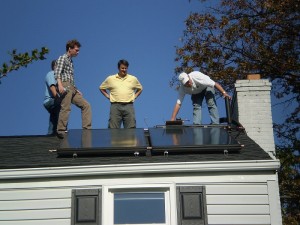 Join the Arlington Solar Co-op
Join the Arlington Solar Co-op
A new solar co-op is now being formed in Arlington. The Arlington Solar Co-op is part of a local, grass roots effort organized by’ EcoAction Arlington , the’ Arlington Initiative to Rethink Energy (AIRE)‘ and’ Virginia SUN’ (a program of Community Power Network), a local non-profit that helps communities go solar.
A final information session about how to go solar and the many benefits of participating in a solar co-op will take place on Thursday, January 15. Get details here. In the meantime, here’s the first of 3 posts on solar.
Going Solar Series: Part 1 of’ 3 ~ Nuts and Bolts
Solar power is now a feasible option for more and more home owners as the price of conventional electricity continues to rise and solar equipment becomes cheaper and more efficient. Installations of solar electric capacity increased 500% between 2008 and 2014 and first quarter 2014 installations were up 28 percent compared with the same period last year, according to the Solar Electric Industries Association. More importantly, the price for installed residential systems dropped 7 percent in the first quarter compared to a year ago. A 30 percent federal tax credit helps to further reduce the costs for home owners.
What is solar power?
Energy hitting the earth from the sun is 10,000 greater than what is consumed so capturing only a fraction of this energy presents a vast opportunity to meet a considerable portion of global energy demand with this renewable resource. The sun’s energy is harnessed two ways: by capturing its heat energy to heat water or space (called solar thermal) or by capturing its light energy to produce electricity (called photovoltaic). Although, solar thermal has a lot of appropriate uses and benefits, this article will focus on using solar to produce electricity.
Photovoltaic (PV) cells are the electricity producing core of solar power systems. Made from silicon (pure sand) electricity is produced when the sunlight hits the PV cell releasing electrons. PV cells are linked together into modules (solar panels) which are connected to each other forming an array (group of solar panels). The size of solar systems is measured in Kilowatts (1,000 Watts) which is abbreviated as KW. Four 250 Watt panels would add up to 1 KW. A small to average size home system is approximately 3 KW, but residential systems can be as small as 1 KW or more than 15 KW. The energy produced by solar panels is measured in kilowatt hours (kWh) which is the same unit that the utility charges you for electricity. Solar cells produce direct current (DC) electricity which flows from the panels to your home.
The DC current requires an inverter to convert the electricity into alternating current (AC) which is used by conventional electrical equipment and your household appliances. Most of today’s solar systems are grid-connected and require no batteries. Instead of using batteries to store electricity onsite, grid-tied systems use the grid like a giant battery. When your solar panels are producing more electricity than can be used by your home, your electric meter runs backwards.
When you use more electricity than can be provided by your solar panels, your electric meter runs forward. A billing arrangement called ‘œnet metering’ allows customers with solar panels to get full credit on their bill for the solar energy they produce charging for only the total or ‘˜net’ amount of energy used ( your total electric usage minus the electricity that your solar panels produced).
It’s important to note that a grid connected system will stop producing if the grid goes down-even if the sun is shining. Homeowners could consider a battery backup system that stores excess electricity in batteries and draws from the grid when batteries are depleted. Such systems may add cost and complexity to the installation d but provide backup power during grid outages.
In rural or isolated areas with no electric grid service, Off grid systems using batteries to store energy are the only option. A vast majority of the solar systems being installed today are grid-connected and do not use batteries.
Now that you know about the nuts and bolts of solar, stay tuned for part 2 in this series, “Is Solar a Good Fit for You?”
